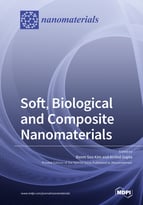Soft, Biological and Composite Nanomaterials
A special issue of Nanomaterials (ISSN 2079-4991).
Deadline for manuscript submissions: closed (30 April 2020) | Viewed by 38282
Special Issue Editors
Interests: bioplastics; biodegradable polymers; molecularly imprinted polymers; polyhydroxyalkanoates; green synthesis of nanoparticles; bioprocess engineering
Special Issues, Collections and Topics in MDPI journals
Interests: bio-based polymers; polymer characterization; polymer nanobiocomposites; polymer processing; shape memory polymers
Special Issues, Collections and Topics in MDPI journals
Special Issue Information
Dear Colleagues,
Progress in the area of nanotechnology has opened the door for the fabrication of soft, biological and composite nanomaterials for targeted applications. Nanomaterials are known to enhance the properties and functionality of the composite materials by several folds. The properties of the desired applications can often be achieved by the addition of small amount of nanomaterials in soft materials such as polymers, gels and biomaterials. Various techniques such as the functionalization of nanomaterials and the fabrication of composites in situ are groundbreaking methods that may lead to a significant improvement in the properties of these materials. Furthermore, there is a need for the focused characterization of the developed materials in order to use them for targeted application, which will ultimately contribute to the future development of nanomaterials and their composites.
Nanomaterials such as nanoparticles and graphene also have tremendous potential for a wide variety of biomedical applications in antimicrobial and antitumor agents, drug delivery, tissue engineering, biosensors, bioimaging and enzyme mimics. Therefore, there is a growing need to develop environmentally friendly processes of nanomaterial synthesis, such as biological methods using microorganisms, enzymes and plants/plant extracts.
In this Special Issue of Nanomaterials, we wish to publish state-of-the-art work focused on the latest developments in the area of nanomaterial composites with soft materials for biological and engineering applications. The current issue also covers different aspects of the novel biosynthesis of nanomaterials, development and characterization of soft, biological and composite nanomaterials and their various applications.
Prof. Beom Soo Kim
Dr. Arvind Gupta
Guest Editors
Manuscript Submission Information
Manuscripts should be submitted online at www.mdpi.com by registering and logging in to this website. Once you are registered, click here to go to the submission form. Manuscripts can be submitted until the deadline. All submissions that pass pre-check are peer-reviewed. Accepted papers will be published continuously in the journal (as soon as accepted) and will be listed together on the special issue website. Research articles, review articles as well as short communications are invited. For planned papers, a title and short abstract (about 100 words) can be sent to the Editorial Office for announcement on this website.
Submitted manuscripts should not have been published previously, nor be under consideration for publication elsewhere (except conference proceedings papers). All manuscripts are thoroughly refereed through a single-blind peer-review process. A guide for authors and other relevant information for submission of manuscripts is available on the Instructions for Authors page. Nanomaterials is an international peer-reviewed open access semimonthly journal published by MDPI.
Please visit the Instructions for Authors page before submitting a manuscript. The Article Processing Charge (APC) for publication in this open access journal is 2900 CHF (Swiss Francs). Submitted papers should be well formatted and use good English. Authors may use MDPI's English editing service prior to publication or during author revisions.
Keywords
- Polymer nanobiocomposites
- Soft nanomaterials
- Novel biosynthesis of nanomaterials
- Nanomaterials for biomedical applications
- Enzyme mimicking nanomaterials
- Characterization of nanomaterials
- Biocompatibility of nanomaterials
- Other biological applications of nanomaterials








